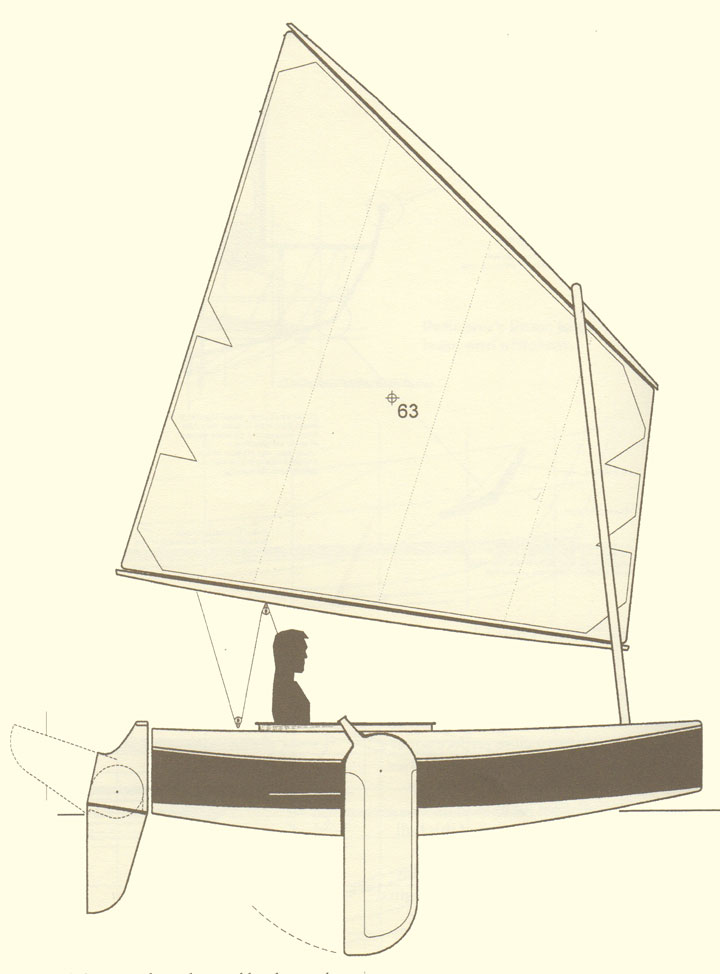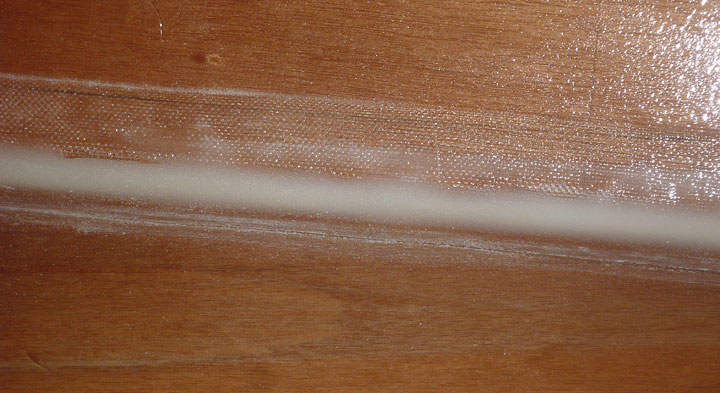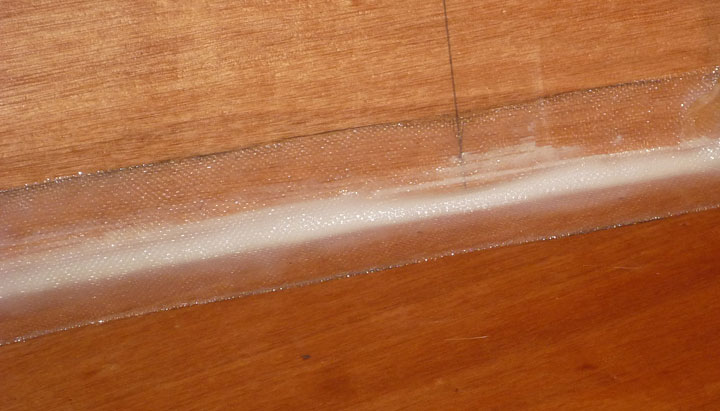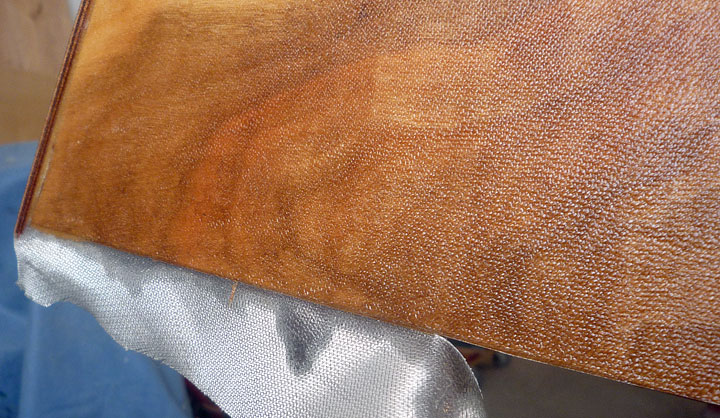|
a Simple Beach Cruiser by John Harris
John Harris owns Chesapeake Light Craft down in Annapolis, Maryland.
Although CLC is best known for its kayak kits, the young designer also draws and builds boats for sail and oar.
A long time ago, he came across Phil Bolger's design for Eeek!, an 11'- 6"
x 24" flat-bottomed sailing canoe of dubious stability (by the designer's own account). To keep her upright under sail, you needed to "lie flat on your back with your eyes just above the gunwale." Eeek! had evolved as a one-third scale test model for a proposed offshore sharpie. All else equal, stability varies with changes in hull length as well as breadth. The 34' - 6" sharpie would prove plenty stable, the shorter canoe would not.
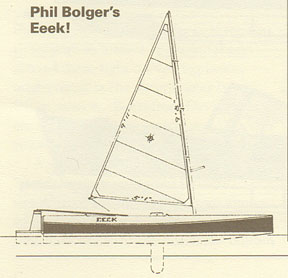
Phil Bolgur's Eeek! Apparently undeterred by the tender (but instructive) Eeek!, Harris commissinned Bolger to draw him a slightly more stable square-sterned pirogue to be powered by a 30-1/2 sq. ft. gaff-headed sail and/or a double-bladed paddle. He assembled two of these plywood pirogues in two weekends and retains fond memories of the boats: "I had some adventures exploring Chesapeake "eelruts" in one of them. To allow paddling, they were 24" wide, and thus desperately tippy under sail. They were under rigged in light air and over rigged the rest of the time. I loved the shape though, and thought the idea could he developed into a comfortable beach cruiser."
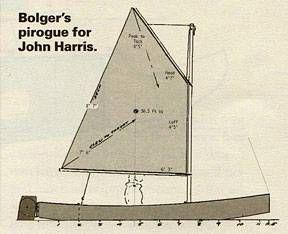
Phil Bolgur's Pirogue for John Harris All of the above has led to the new Eelrut 10, fresh from Harris's drawing table. Here we have a wider (3' - 4"), more commodious and able beach cruiser, yet construction remains blindingly quick and simple. The 10' hull will be built with 1/4" sheet plywood and will weigh from 80 to 100 lb. (hull only? gem), depending upon the species of the chosen wood and details of fitting out. Harris describes the new boat: "It's cheap and simple and will sail well no matter how much or little time you put into it. I haven't yet finished drawing the expanded (real, flattened-out shape) panels, but you can guess they're pretty simple." The rocker (longitudinal curvature) to Eelrut's flat bottom might seem excessieve at casual glance, but experienced shallow-water sailors will see it as just right. By more nearly matching the sweep of the bottom to the curve of the hull sides, this shape reduces crossflow at the chines and results in more predictable handling (less "rooting"), easier propulsion, and a better-balanced helm.
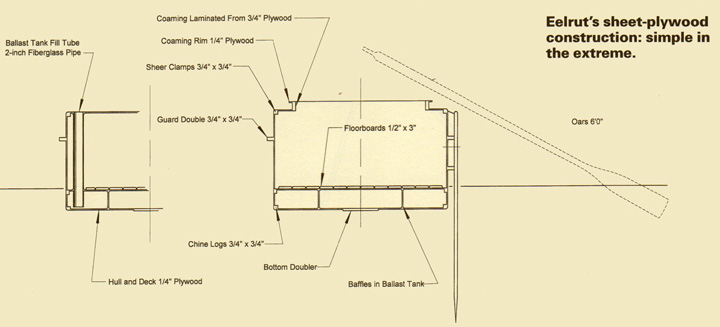
The absolutely perpendicular hull sides help with this equation, as well as offering maximum initial stability for the given overall breadth. Power to carry sail will be enhanced by an integral ballast tank, which will hold a maximum of 130 lb. of water, below the cockpit sole. Harris explains its operation: "To add or subtract ballast, you insert one of those ordinary gray plastic hand-held pumps in a large diameter fiberglass tube led through the deck. This allows adjustment while afloat, which isn't possible with an underwater drain plug." He adds that we might omit the ballast tank if we are "selective about our sailing weather." The large rudder, with its pivoting kick-up blade, will eliminate any worries about control. Harris has drawn a substantial 12" diameter bearing surface between that blade and cheek pieces. Smaller bearing circles, found on many stock boats, produce rudders that often feel too flexible and risk eventual structural failure. In addition, large bearing areas seem to offer just the right amount of friction to keep the blade happily at any desired angle of tilt.
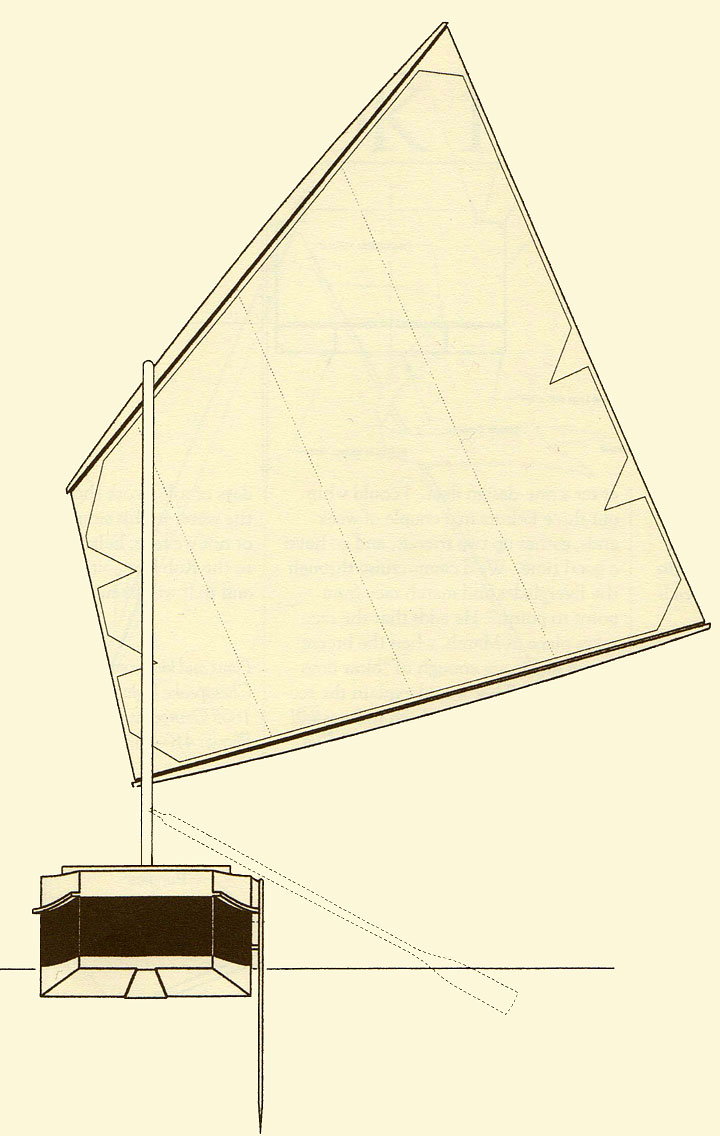
Viewed from aft
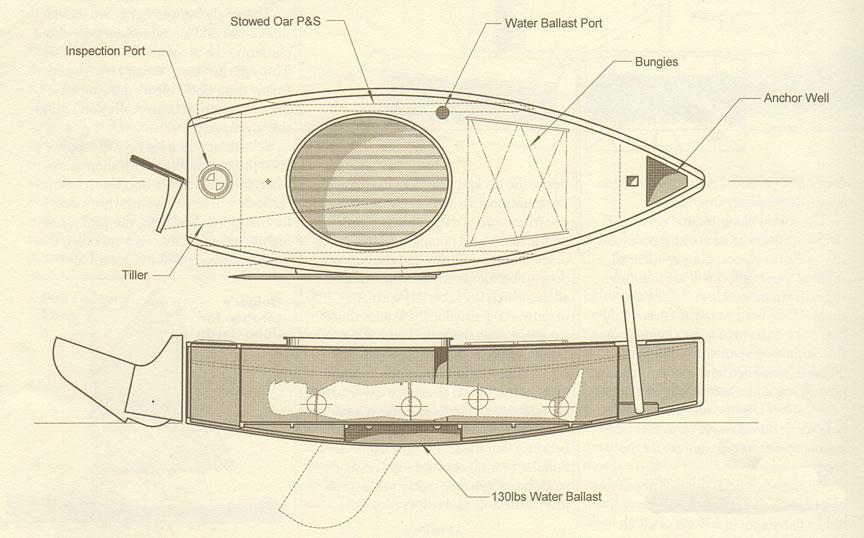
Water Ballast The single lee/weather board provides simple-to-build lateral resistance without cluttering the accommodations. Through the years, similar arrangements (many from Phil Bolger's drawing table) have proven that boats really don't mind this asymmetry. Eelrut's standing lug rig will supply good power combined with short sticks. Mast, yard, and boom won't stow below, but they will lash down neatly on deck for transport. As drawn, the yard is not highly peaked. If this rig were taller, that yard might slough off to leeward in annoying fashion and seriously impede our progress to windward. Given this sail's short stature, we should be in fine shape for cruising. If you want a sophisticated windward machine, you're readá ing the wrong page. While drawing this simple cruising canoe, Harris kept in mind the 300 mile Watertribe Everglades Challenge along Florida's Gulf Coast: "That race attracts a lot of wild boats and some wooly, iron-man type racers. It might be fun to enter a one-design fleet. I could whip out three Eelruts in a couple of weekends, gather up two friends, and go have a good time. WeĠd camp-cruise through the Everglades and match race from point to point." He adds that the race takes place in March, when the breeze comes on strong enough to "blow dogs off chains." That would explain the second set of reefpoints, which reduces sail area to the size of a large handkerchief. A few sheets of 1/4" plywood and two days of solid work should get us out on the water in this simple boat. Whether or not we race, Eelrut can take us closer to the Rob Roy spirit of beach cruising, and that will he healthy fun. M.O'B.
Plans and kits from John Harris, Grant MacLaren comments: I emailed John Harris to buy a set of plans, and he replied, saying he hadn't finished drawing them. He was very pleased to see Eelrut featured on the cover of BDQ No. 37. So I measured the drawings as published in BDQ, calculated the percentage needed to enlarge them to yield 1" = 1' Xerox copies, and headed to Kinkos. (The cover illustration needed 235%, as did some of those inside the magazine. Others needed 222%.) I drew enough lines (as in 1-inch graph paper) to scale off some dimensions such as transom height and width, rocker, mast rake, etc. And, I decided to make the bow 6 inches wide, thinking the side panels will then be closer to 10 ft. in length. I have some nice mahogony boards from old sailboats to make rudder and lee/weather board:

The rot will be trimmed off, and what's left will determine dimensions. I aslo have some spars from an old Old Town sailing canoe. I think my rudder will be "fixed" with gudgeons and pintles; most sailing will be done on deep Wisconsin lakes. I have some nice aluminum to make the "steering crank."
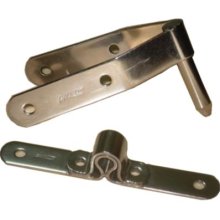
I like the water ballast idea, but think the water could be controlled via a hole in the bottom of the boat, and a "ball" valve in a vent pipe running to deck. Again, most sailing will be done in deep Wisconsin lakes, with boat launched from a pier, making it easy to drain the ballast. Will probably avoid use of sheer clamps, chine logs, etc. I'll "stitch and glue" the plywood (underlayment) hull panels together, and cover the hull outside with 'glass cloth as I did when building Uncle Richard:
|
